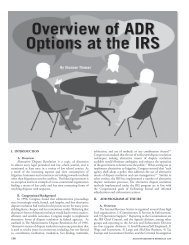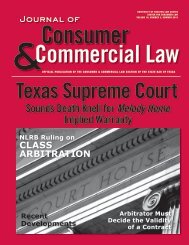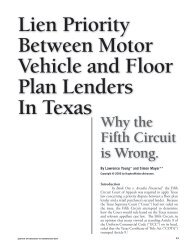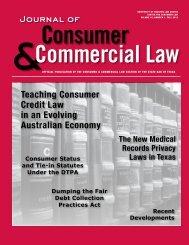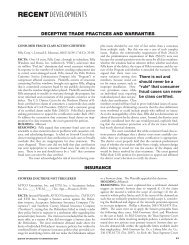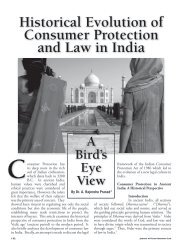The McDonald's Coffee Lawsuit - Journal of Consumer ...
The McDonald's Coffee Lawsuit - Journal of Consumer ...
The McDonald's Coffee Lawsuit - Journal of Consumer ...
You also want an ePaper? Increase the reach of your titles
YUMPU automatically turns print PDFs into web optimized ePapers that Google loves.
ut out <strong>of</strong> the billions <strong>of</strong> cups <strong>of</strong> c<strong>of</strong>fee we sell,<br />
there’s not been enough burned to where we need<br />
to stop selling it that hot?”<br />
A: <strong>The</strong>re’s a very low probability <strong>of</strong> an accident as<br />
a result <strong>of</strong> using the product and we know that the<br />
customers want the product hot so we’re at this time<br />
continuing with our current practice. . . .<br />
Q: Mr. Appleton, do you know how McDonald’s<br />
Corporation informs itself <strong>of</strong> the severity <strong>of</strong> the<br />
burns that are recorded on Plaintiff’s Exhibit No. 3?<br />
Do you know what they do to ascertain how serious<br />
those burns are?<br />
A: I’m not intimately familiar with the process.<br />
I believe it’s handled through our insurance<br />
company.<br />
Q: So for you to say that you haven’t formulated a<br />
conclusion that there have been enough severe burns<br />
to warrant turning down the temperature on your<br />
c<strong>of</strong>fee, you are speaking without knowledge <strong>of</strong> the<br />
extent and severity <strong>of</strong> the burns that were reflected<br />
in those computer printouts, is that right?<br />
A: I think that I don’t think we have a good<br />
measure <strong>of</strong> the severity <strong>of</strong> each <strong>of</strong> these.<br />
Q: Well, I’m curious because I’ve shown you<br />
recordations here <strong>of</strong> some 700 people here that have<br />
been burned. Obviously, to you 700 people burned<br />
is not a significantly high enough number to turn<br />
down the heat. Do you have in mind a number<br />
<strong>of</strong> how many people would have to be burned for<br />
you to become so concerned that you would insist<br />
that burn specialists be consulted and something be<br />
done to sell this c<strong>of</strong>fee at a lower temperature?<br />
A: No, I don’t have a number in mind. 50<br />
At trial, McDonald’s argued that Liebeck<br />
contributed to her own injuries by placing the c<strong>of</strong>fee cup<br />
between her legs and by not removing her clothing promptly<br />
after the spill. 51 McDonald’s further alleged that the severe<br />
nature <strong>of</strong> the burns suffered by Ms. Liebeck were worse than<br />
usual because <strong>of</strong> her older skin making her more vulnerable<br />
to more serious injuries. 52 A McDonald’s executive testified<br />
that McDonald’s had chosen not to warn its customers <strong>of</strong> the<br />
possible severe burns its c<strong>of</strong>fee could cause because “(t)here are<br />
more serious dangers in restaurants.” 53 McDonald’s human<br />
factors engineer admitted that the number <strong>of</strong> hot c<strong>of</strong>fee<br />
burns suffered by McDonald’s customers are “statistically<br />
insignificant” in comparison to the one billion cups <strong>of</strong> c<strong>of</strong>fee<br />
sold by McDonald’s each year. 54<br />
<strong>The</strong> jury deliberated after hearing seven days <strong>of</strong><br />
evidence, testimony, and arguments <strong>of</strong> counsel, finding that<br />
McDonald’s was liable on the claims <strong>of</strong> product defect, breach<br />
<strong>of</strong> the implied warranty <strong>of</strong> merchantability, and breach <strong>of</strong><br />
the implied warranty <strong>of</strong> fitness for particular purpose. 55 <strong>The</strong><br />
jury further determined that Ms. Liebeck’s injuries merited<br />
an award <strong>of</strong> $200,000 compensatory damages. 56 However,<br />
because the jury found that Ms. Liebeck was 20% at fault,<br />
that award was reduced proportionately to $160,000. 57<br />
Finally, the jury awarded Ms. Liebeck $2.7 million in punitive<br />
damages based on its finding <strong>of</strong> willful, reckless, malicious,<br />
or wanton conduct. 58 <strong>The</strong> amount <strong>of</strong> $2.7 million was<br />
arrived at based on evidence the jury heard that McDonald’s<br />
daily c<strong>of</strong>fee revenues amounted to approximately $1.34<br />
million. 59 <strong>The</strong>se exemplary damages represented about two<br />
days worth <strong>of</strong> McDonald’s c<strong>of</strong>fee revenues. 60 However, a<br />
fact that rarely ever makes headlines (in this case, or in any<br />
<strong>Journal</strong> <strong>of</strong> <strong>Consumer</strong> & Commercial Law<br />
allegedly “fraudulent” lawsuit) is that the punitive damages<br />
were reduced by the trial court to $480,000 (three times the<br />
compensatory damages) for a total award <strong>of</strong> $640,000. 61<br />
Judge Robert H. Scott, who presided over this trial, stated in<br />
regard to the reduced punitive damages award:<br />
I think that there was evidence and<br />
argument about the Defendant’s knowledge that the<br />
c<strong>of</strong>fee could cause serious, third degree, full tissue<br />
burns. <strong>The</strong> Defendant McDonald’s knew that the<br />
c<strong>of</strong>fee, at the time it was served, was too hot for<br />
human consumption . . . .<br />
[T]he written transcript is not going<br />
to reveal the attitudes <strong>of</strong> corporate indifference<br />
presented by demeanor or <strong>of</strong> the witnesses for the<br />
Defendant McDonald’s as well as their employees,<br />
but the jury was exposed to it and I think that they<br />
properly considered it in their deliberations. And<br />
let me say that with knowing the risk <strong>of</strong> harm,<br />
the evidence and testimony would indicate that<br />
McDonald’s consciously made no serious effort to<br />
warn its consumers by placing just the most simple,<br />
adequate warning on the lid <strong>of</strong> the cup in which the<br />
c<strong>of</strong>fee was served. . . . This is all evidence <strong>of</strong> culpable<br />
corporate mental state and I conclude that the award<br />
<strong>of</strong> punitive damages is and was appropriate to punish<br />
and deter the Defendant for their wanton conduct<br />
and to send a clear message to this Defendant that<br />
corrective measures are appropriate. 62<br />
Judge Scott ordered the parties to engage in a postverdict<br />
settlement conference which resulted in a settlement<br />
<strong>of</strong> the case for an undisclosed amount (less than $600,000)<br />
which remains confidential. Ms. Liebeck’s case was dismissed<br />
with prejudice on November 28, 1994. 63<br />
McDonald’s has taken some remedial measures in<br />
the aftermath <strong>of</strong> the Liebeck lawsuit. Many McDonald’s<br />
drive-thrus now have a sign warning, “<strong>C<strong>of</strong>fee</strong>, tea and hot<br />
chocolate are VERY HOT!” Also,<br />
the lids <strong>of</strong> McDonald’s hot beverage<br />
cups are now embossed with the<br />
words “HOT! HOT! HOT!” It<br />
is debatable whether the c<strong>of</strong>fee at<br />
McDonald’s is served any cooler<br />
than the c<strong>of</strong>fee that injured Ms.<br />
Liebeck. Some sources indicate<br />
that McDonald’s current policy is<br />
to serve c<strong>of</strong>fee between 175-195<br />
degrees Fahrenheit. 64 <strong>The</strong> industry<br />
standard still calls for near boiling<br />
temperatures for the best-tasting<br />
c<strong>of</strong>fee. 65 It appears that the current<br />
reaction to c<strong>of</strong>fee lawsuits is to do a<br />
better job <strong>of</strong> warning, but maintain<br />
the temperature for better tasting<br />
java.<br />
Our pr<strong>of</strong>ession<br />
can and must<br />
do our part to<br />
help change<br />
the public<br />
perception <strong>of</strong><br />
our legal system.<br />
What can be learned from this case? First, the<br />
McDonald’s c<strong>of</strong>fee case is not a frivolous lawsuit, as many<br />
people believe. In fact, Ms. Liebeck had a very strong case<br />
against a very unsympathetic corporate defendant. An<br />
argument can obviously be made that the punitive damages<br />
should not have been decreased, especially in light <strong>of</strong> the<br />
purpose <strong>of</strong> punitive damages. A judgment <strong>of</strong> $480,000<br />
certainly would not be the same deterrent as $2.7 million.<br />
Second, our pr<strong>of</strong>ession can and must do our part to<br />
help change the public perception <strong>of</strong> our legal system.<br />
17



